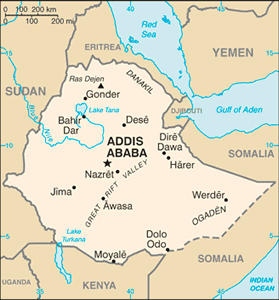The Geography of Ethiopia
The Geography of Ethiopia
Ethiopian Geography
Location: Eastern Africa, west of Somalia
Geographic coordinates: 8 00 N, 38 00 E
Map references: Africa
Area: total: 1,127,127 sq km land: 1,119,683 sq km water: 7,444 sq km
Area - comparative: slightly less than twice the size of Texas
Land boundaries: total: 5,328 km border countries: Djibouti 349 km, Eritrea 912 km, Kenya 861 km, Somalia 1,600 km, Sudan 1,606 km
Coastline: 0 km (landlocked)
Maritime claims: none (landlocked)
Climate: tropical monsoon with wide topographic-induced variation
Terrain: high plateau with central mountain range divided by Great Rift Valley
Elevation extremes: lowest point: Danakil Depression -125 m highest point: Ras Dejen 4,533 m
Natural resources: small reserves of gold, platinum, copper, potash, natural gas, hydropower
Land use: arable land: 10.01% permanent crops: 0.65% other: 89.34% (2005)
Irrigated land: 2,900 sq km (2003)
Natural hazards: geologically active Great Rift Valley susceptible to earthquakes, volcanic eruptions; frequent droughts
Environment - current issues: deforestation; overgrazing; soil erosion; desertification; water shortages in some areas from water-intensive farming and poor management
Environment - international agreements: party to: Biodiversity, Climate Change, Climate Change-Kyoto Protocol, Desertification, Endangered Species, Hazardous Wastes, Ozone Layer Protection signed, but not ratified: Environmental Modification, Law of the Sea
Geography - note: landlocked - entire coastline along the Red Sea was lost with the de jure independence of Eritrea on 24 May 1993; the Blue Nile, the chief headstream of the Nile by water volume, rises in T'ana Hayk (Lake Tana) in northwest Ethiopia; three major crops are believed to have originated in Ethiopia: coffee, grain sorghum, and castor bean


